Gorillas are intelligent animals with superior communication skills. These magnificent apes are remarkable in their ability to incorporate complex communication.
To give a clue in terms of their superior communication skills, we would like to point out one thing: their vocalization. Scientifically, the gorilla’s vocalization is termed “belch vocalization.” This is a deep, rumbling sound that gorillas produce by inhaling and then belching out air, and it is unique to gorillas among primates.
However, knowing all gorillas’ behavior is important to ensure their existence, triggering effective conversation. And their conservation is crucial for their local ecological environment. Here, we are going to explore each behavioral fact of gorillas, including growing, feeding, and breeding behavior, ecological adaptation, aggression, and more.
Behavioral Facts of Gorilla
Gorillas showcase some unique behavioral characteristics in terms of communication, interaction with each other, foraging, etc. Below is a graphical representation of some of the most crucial behaviors of gorillas and the associated reasons.
| Behavioral Facts | Behavior |
|---|---|
| Growing habit | 01. Early age: less hearing capacity, less muscle power, grayish-pink fur. 02. Young age: high hearing capacity, strong muscle, gray-black fur 03. Old age: lower hearing capability, less strength in muscles, brown-gray, dark black-gray, or black-silver color fur |
| Feeding habit | 01. They are herbivorous, but some species eat insects, snails, and worms 02. Mainly feed on leaves, shoots, stems, etc. 03. They forage during the day for food |
| Activity pattern | Foraging food and rest during the day; sleep at night |
| Social behavior | Cooperation, conflict, aggression, etc. |
| Mating and breeding behavior | Males fight for access to counterparts |
| Aggression and territorial behavior | Shows aggressive behavior to protect food resources, nest, family, and leadership position |
Read this article to know more about gorilla overview”
Why Do Gorillas Behave Significantly?
Gorillas exhibit more complex behaviors than other apes. These behaviors are influenced by their social structure, environment, and genetics. And these are considered a reflection of their intelligence and adaptation ability. Therefore, comprehending their behavior is essential for conserving and protecting them.
Significance of Understanding the Diversified Behavior of Gorillas
We know that gorillas play a significant role in the ecosystem. Following this, we must understand that their preservation in their natural habitat is more than essential. And to ensure the conservation of the great animal, an in-depth understanding of their behavior comes first. Here, we discuss that
Growing Habits of Gorillas
Gorillas go through several growth phases. Following are the growing habits they pass through all around their life.
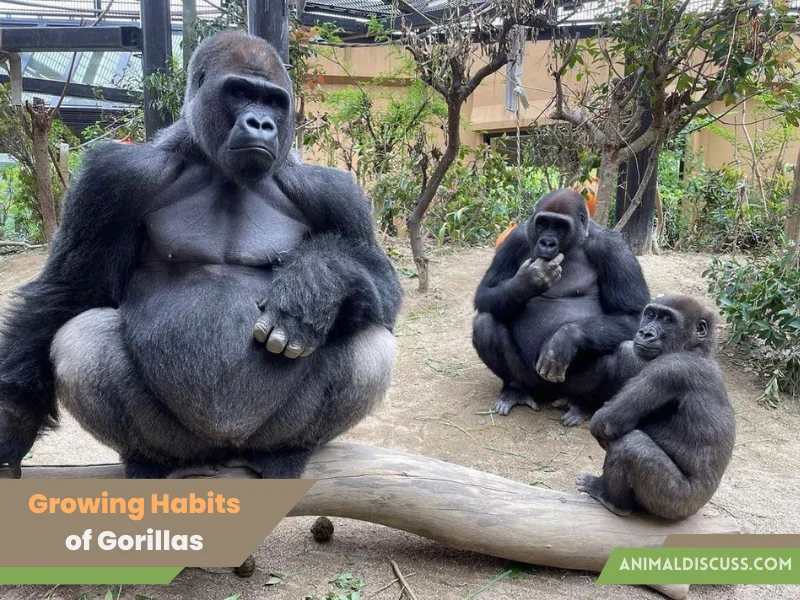
Structural and Physical, and Biological Adaptations
Gorillas go through several physical and biological development stages to become adults. They are as follows.
Infants (0-3 years age range)
Gorilla infants weigh around 2-4 pounds and have a length of 16–18 inches. Their body is covered with soft and black fur. Gorillas in this age group are capable of hearing the vocalizations of their mother and other group members. But, not that capable of differentiating between those vocalizations.
Weaning Stage
At around 6 months of age, gorilla infants gain a weight of 8-10 pounds and a length of 20-24 inches. Their digestive system becomes mature to deal with solid food/ They start to learn the foraging process. Most importantly, at this stage, they receive slow progress in hearing capability development.
Juveniles
Gorilla juveniles, aged from 3 to 6 years old, typically weigh between 35 and 70 pounds and have a height ranging from 2.5 to 3.5 feet. They possess a slender and lanky physique that facilitates their movement through trees and other vegetation with greater ease.
At this age, they start to learn the use of complex vocalizations to make complete communication.
Sub-adults
Gorillas’ sub-adult age group is considered between 6 and 10 years. At this stage, they begin to exhibit more adult-like behaviors, such as chest-beating, looking for mates, etc. In the sub-adult age group, their weight becomes 90–160 pounds, and their height is 3.5 — 4.5 feet. They are still growing and developing physically and socially.
Along with several physical and social developments, their hearing capability also receives development. At this stage, they can detect a wider range of sounds and frequencies.
Adult females
Adult female gorillas weigh around 150–200 pounds and measure about 4-5 feet tall. They are responsible for caring for their young and foraging for food for the group.
Blackbacks/adult males
Adult male gorillas, also known as blackbacks, weigh around 300–400 pounds and measure about 5–6 feet tall. Their chest is broad and massive. They are also equipped with powerful arms that are adapted for fighting and defending their family group from predators and other males.
Young silverbacks
Young silverback gorillas weigh around 400–500 pounds and measure about 5.5–6.5 feet tall. They are still growing and developing physically and socially and may begin to challenge the dominant silverback for control of the group.
Silverbacks
Silverback gorillas are the largest and most powerful members of the group. Each silverback’s weight ranges between 400–600 pounds. At this period of the life cycle, they carry a distinctive mark: silver hair on their backs.
Growth Habit differences (Table):
| Different growth stages | Weight (Pounds) | Size | Role | Communication |
|---|---|---|---|---|
| Infants (0-3 years age range) | 2-4 | 16-18 inches | Dependent on mother | Capable of hearing others but cannot understand |
| Weaning Stage | 8-10 | 20-24 inches | Learn to forage | Slow progress in hearing capability development |
| Juveniles | 35-70 | 2.5 to 3.5 feet | Start to follow the other gorillas’ behavior | Learn the use of complex vocalizations |
| Sub-adults | 90-160 | 3.5-4.5 | Exhibit more adult-like behaviors | Can detect a wider range of sounds and frequencies |
| Adult | Male: 300-400 Female:150-200 | Male: 5-6 feet Female: 4-5 feet | Female: food finding, child care, etc. Male: food foraging, fighting, defending, etc. | Can incorporate complex communication |
| Young silverbacks | 400-500 | 5.5-6.5 feet | All other behavior of the Blackback period plus begin to challenge the dominant Silverback | Can incorporate complex communication. Can make decisions |
| Silverbacks | 400-600 | 5.5-6.5 feet | Responsible for protecting the group, decision-maker, etc. | Communication skills reach the height level. |
Feeding Habits of Gorillas
Gorillas are primarily herbivores. Their diet mainly consists of leaves, stems, and shoots. They also consume fruits and flowers. The feeding habits of gorillas are described as follows.
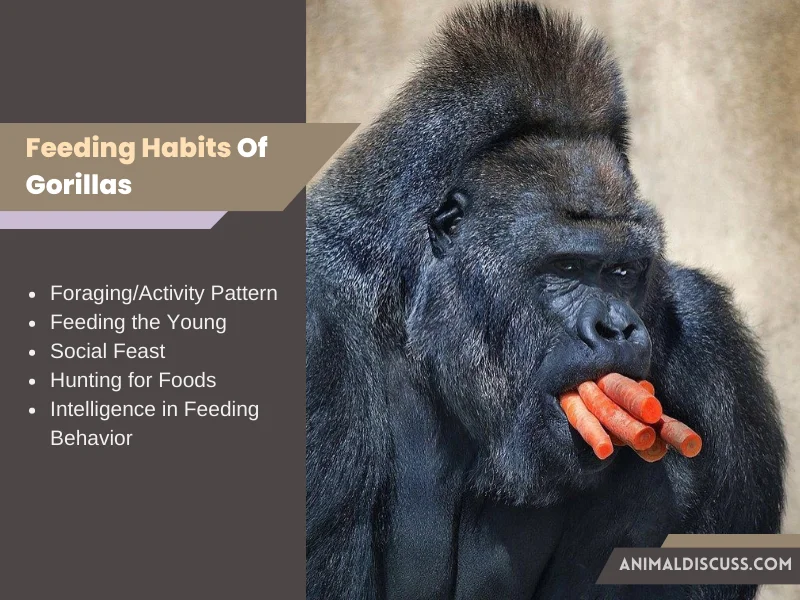
Foraging/Activity Pattern
Gorillas showcase group behavior when foraging for food. They search for food in a group, and upon finding the whole group stop in that place, collect the food, and eat on the spot. It should be mentioned that gorillas forage for food during the day.
As mentioned earlier, gorillas often travel long distances for food, and their diet may vary depending on the season and availability of resources in their habitat.
Feeding the Young
Mother gorillas breastfeed their infants for the first few months. And after the infants reach 5 months, the mother introduces them to solid food.
Social Feast
Gorillas live in groups. And their feeding activities are a communal feast. They forage for food together and sometimes share with others. In most cases, the dominant male has priority access to specific food resources.
They are allowed to choose a certain food source containing a larger amount of quality and greater quality.
Hunting for Foods
It is for sure gorillas are primarily herbivores, but there are times when they hunt small animals such as insects, snails, small rodents, etc. Gorillas use their hands and feet to dig for insects or catch small animals in these cases. They may also use tools such as sticks to probe for insects.
Intelligence in Feeding Behavior
It has been observed that gorillas use superior intelligence in several feeding behaviors. First of all, it is commonly observed that they use their hands to strip leaves from branches or use their teeth to bite off sections of tough vegetation.
Secondly, they use their mouths to carry food and their feet to hold branches while they eat.
Breeding and Migration Pattern of Gorillas
Understanding the breeding and migration patterns of gorillas is important for conservation efforts. This understanding is also crucial for gaining insight into their natural history and ecology.
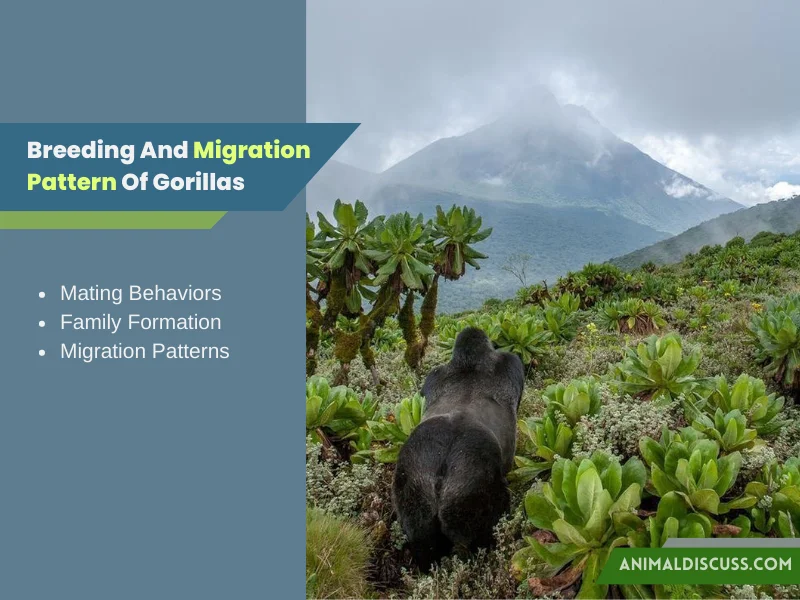
And the associated studies assist in developing strategies to protect and preserve gorilla populations and their habitats.
Mating Behaviors
Gorillas have a polygynous mating behavior. Following this, the highly dominant male mates with multiple females within a group. The higher the dominance, the higher the mates’ number.
Most importantly, females remain fertile for a few days each month, and during this period, males fight against each other for access to females. However, females are also naturally triggered to mate with multiple males.
Lastly, gestation lasts about 8.5 months, and females give birth to a single offspring at a time.
Family Formation
A gorilla couple lives in a family with their offspring in a larger group. Here, we want to mention that eventually, every family is male-dominated and has multiple adult females.
Young males leave their natal troops to join other troops or form their own. Female offspring may remain with their natal troop for their entire lives.
Migration Patterns
In general, migration is the seasonal movement of animals from one place to another. They migrate to find food, water, or suitable breeding grounds. This theory is not accurately applicable to gorillas.
Gorillas are not known to migrate in the traditional sense, but they do showcase patterns of ranging behavior. They showcase ranging behavior if the respective area is running out of food or there are potential threats.
Ecological Adaptations of Gorillas
Gorillas are unique in terms of ecological adaptation. They contribute to the ecosystem in various ways. Below is a comprehensive discussion.
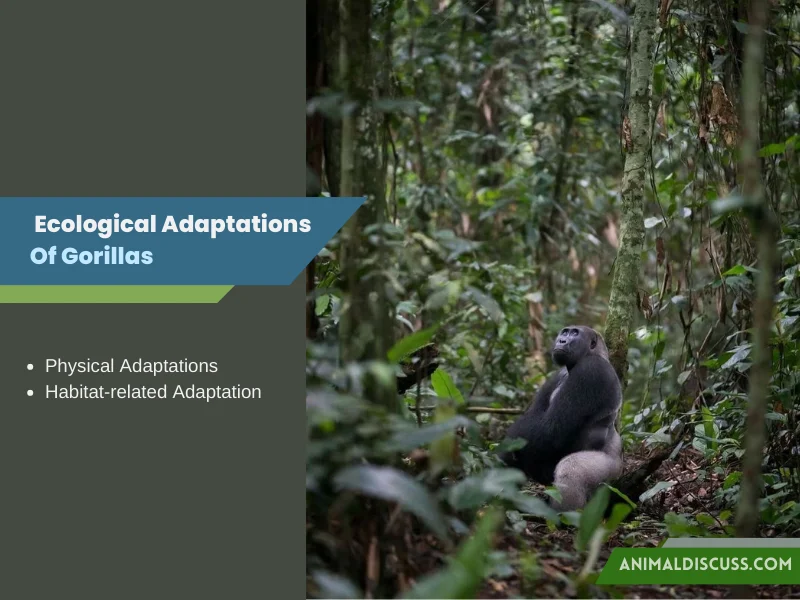
Additionally, these animals are dangerous animals within their range. They keep other herbivores far away, restricting overgrazing.
Diet Adaptation
Following their herbivorous characteristics, the gorilla’s digestive system has evolved to break down tough plant fibers. Also, their teeth are adapted to grind and chew these foods, from soft to hard.
Physical Adaptations
In terms of the physical adaptation of gorillas, we would like to mention three particular things:
- Their arms have been developed in strong-muscular formation to climb and swing through trees easily.
- They have broad, powerful legs and solid body structures to deal with the obstacles on the ground in the deep forests.
- Gorillas’ hands and feet have opposable thumbs and toes, which allow them to grasp and hold onto branches and other objects.
Habitat-related Adaptations
Gorillas inhabit tropical and subtropical forests, and their ecological adaptations suit this environment well. They rely on the dense vegetation for food. And they are experts in moving through the forest canopy while accessing different food storages.
Aggression and Territorial Habits of Gorillas
Though gorillas are peaceful animals, they show aggression and territorial habits to ensure survival in the wild.
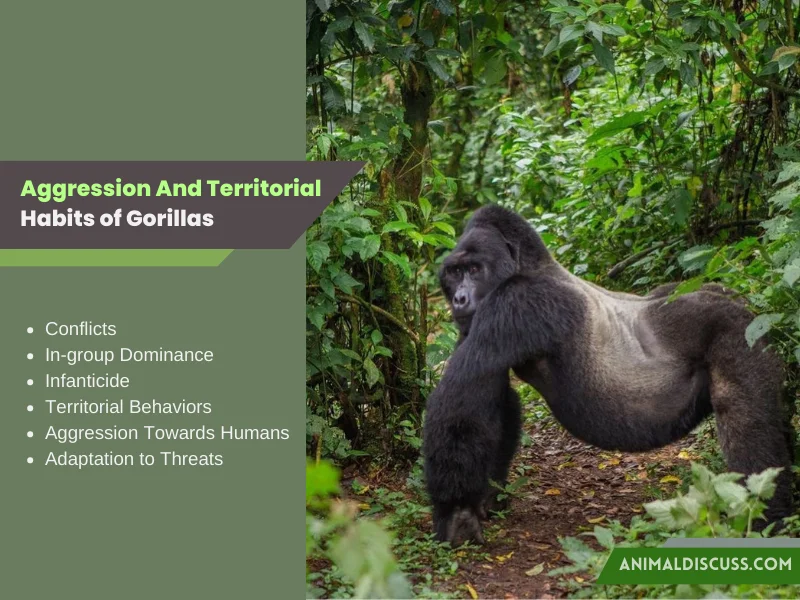
Conflicts
Individual gorillas eventually get involved in physical conflicts to get access to food, shelter, and mates. They also participate in physical conflicts against other groups.
In the conflicting situations, they showcase aggressiveness in terms of chest-beating, screaming, and charging to assert dominance and protect their territory.
In-group Dominance
Within a troop of gorillas, a clearly-observable hierarchy is present. Subordinate individuals may display submissive behaviors to avoid aggression from dominant individuals. Dominant males and females have greater access to rich food sources and better living places.
Infanticide
After gaining the leading position in a group, the new male leader male sometimes kills the offspring of the previous leader of the group. This is to ensure that his genes are passed on.
Territorial Behaviors
Gorillas mark their territory with scents. They also use vocalizations to mark their area, such as hoots and barks. These sounds warn other gorillas and animals if they want to enter the acquired territory.
Aggression Towards Humans
Gorillas are generally shy and avoid contact with humans. But they become aggressive if they feel threatened or cornered. However, attack on humans occurs when gorillas have become habituated to humans, such as in tourist areas.
Adaptation to Threats
Gorillas face a number of threats in their lifetime, including predation, disease, and habitat loss. In present days, they are also receiving threats from humankind’s activities like deforestation, mining in the jungle, logging, etc.
As they grow, they learn how to adapt to these threats. The adapted approaches include:
- Avoiding areas with high predator activity.
- Developing immunity to diseases.
- Adapting to changes in their environment.
- Avoiding areas dominated by humans.
Social Behaviors of Gorillas
Troops or bands of gorillas are formed by one dominant silverback male, numerous adult females, and their offspring. Group sizes might vary from a few people to over 20 members.
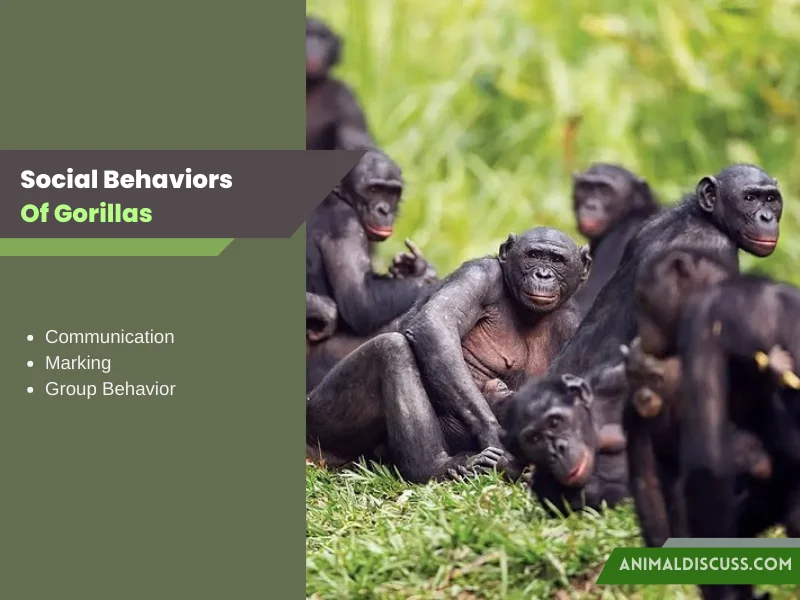
They often engage in numerous social behaviors, such as grooming, playing, and engaging in physical contact. The dominant silverback maintains order and guards the group, while females care for the children and maintain ties with other members.
There are some social traits the animal display:
Communication
From a very early age, gorilla babies start to learn communication skills. Babis closely observe their mothers’ communication behaviors, and slowly they adapt various forms of vocalizations, body language, and facial expressions.
From the beginning of their advanced period, the young gorillas became familiar with the complex communication system. They start to use different sounds and postures to convey messages, such as warning signals, mating calls, and greetings.
They also use visual cues such as chest beating and other displays to assert dominance or communicate aggression.
Marking
By nature, gorillas are equipped with a sophisticated sense of smell. Gorillas eventually started to use this unique characteristic from their adolescent period to mark their territory and communicate with other members of their group.
They leave scent marks on trees or other objects in their territory to indicate their presence. Additionally, adult male gorillas have large apocrine glands in their armpits. When they feel scared, excited, or stressed, this gland activates and circulates a pungent smell.
Group Behavior
Every animal living is equipped with some group behaviors regarding communication, play, activities, etc. Gorillas are also not separated from this. They live in a troop formation and practice some social behavior to ensure survival.
They communicate with each other through a variety of vocalizations and body language. And they also use these cues to establish dominance in the group while maintaining collective cohesion.
Most surprisingly, it has been observed that gorillas engage themselves in grooming; they help each other to keep the fur clean and lice-free. They also actively participate in playful activities in a group.
Facts that Influence Different Behavioral Traits
Gorillas’ behavioral traits also receive transpositional contexts due to several factors like genetics, age, climate, etc.
Below is a complete detail of such influential factors.
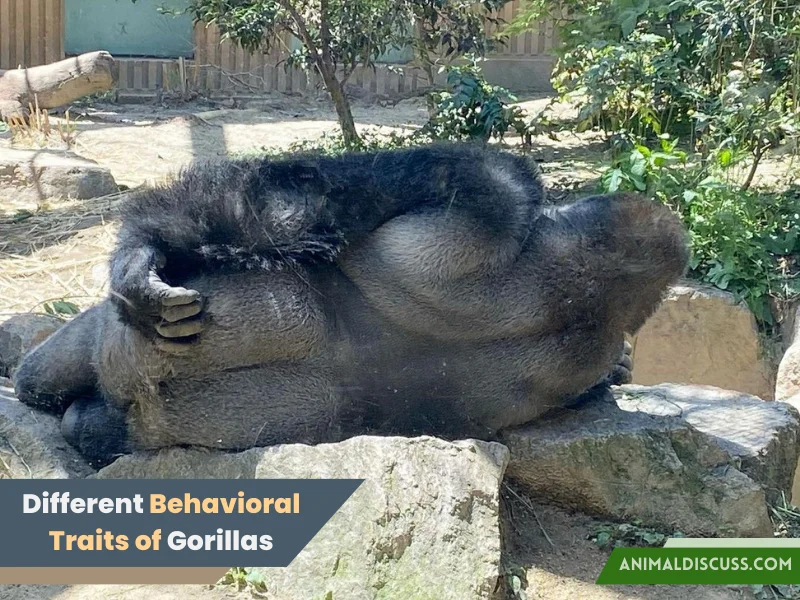
Social Structure: The social structure of gorilla troops plays a crucial role in shaping their behavior, including their interactions with other gorillas, care for their offspring, and use of communication and aggression. Silverbacks are designated as the leader; females and blackbacks along with the offspring follow the decisions of the silverbacks.
Genetics: The associated genetics significantly influences Gorillas’ behavioral traits, temperament, social skills, and cognitive abilities.
Climate: The behavior of gorillas is heavily influenced by climate, affecting various aspects such as foraging, movement, reproduction, and habitat preferences. Contemporarily, climate change is altering the forests, causing gorillas to leave those areas and search for a new suitable habitat.
Habitat, and Food Availability: Habitat type and food availability can all influence the behavior of gorillas. For example, the gorillas’ habitat in an area with low food resources is used to be more aggressive with each other and other groups.
Age: Age is also a vital factor influencing their behavioral traits. As an example, young gorillas engage in more play behaviors than adults. In contrast, adult males are more concentrated on gaining and maintaining their supremacy in the group.
Environment: A gorilla raised in captivity does not showcase similar behavior to other gorillas raised in a wild setting.
Gender: Male gorillas show a higher degree of aggressiveness and dominance than females. Again, regarding caregiver criteria, females are considered primary caregivers of the offspring, while males protect the babies. Lastly, males are the decision-makers, and females are the followers.
Human-Induced Facts that Change Gorillas’ Behavior
Human activities also significantly affect gorillas’ behaviors. Let’s explore human contribution to gorillas’ behavioral change.
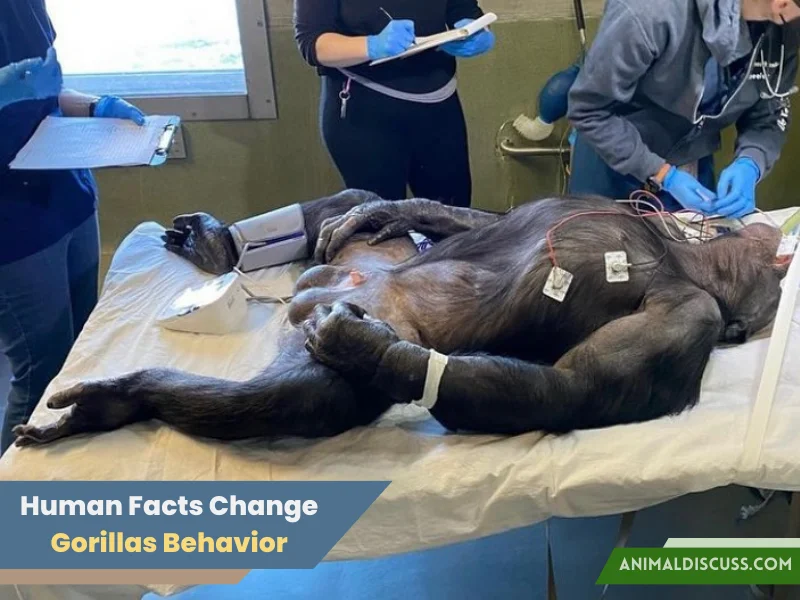
Destruction of Gorillas’ Habitat: The human population is growing tremendously, and mass deforestation takes place to meet their food and other necessities. The related activities are logging, mining, cultivating, etc.
These activities welcome the destruction of the natural habitats of gorillas. And force them to move to new environments, adapting to the condition of the new environments and competing for resources with other animals.
Consumption of Ape Meats and Prejudice: The consumption of ape meat is considered highly healthy and symbolizes the prestige of wealthy people in many regions. To get the meat, known as urban meat, humans kill gorillas.
Also, some body parts of gorillas are considered to power up humans’ sexual life; it is also a reason for gorilla poaching. However, this context imports behavioral changes in gorillas, making them aggressive and avoiding humans.
Increasing Gorilla Tourism: The increasing popularity of gorilla tourism also impacts the behavior of gorillas. Habituation to humans can result in changes in social behavior, including increased aggression or dependence on humans for food.
Environmental Pollutions: Pollution and other forms of environmental degradation can also impact the behavior of gorillas. Due to contamination, some of the gorillas may experience a significant change in behavior due to the associated chemical reaction in their blood.
Conservation of Gorilla Behavior
Conservation of the behavior of gorillas is essential to ensure their survival and well-being in the wild. It results in maintaining the balance of nature in the environment.
Below are the approaches that we can apply to ensure effective conservation.
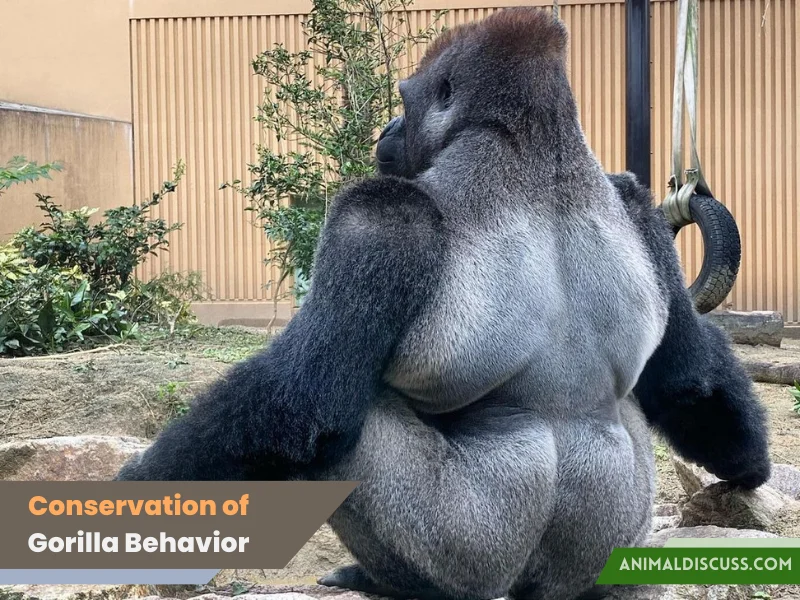
- Humans must take the initiative to preserve forests and other natural settings that provide gorillas with food, shelter, and social structures.
- Conservation efforts must minimize habitat destruction, poaching, and pollution to ensure that gorillas can behave naturally and live without interference.
- Eco-tourism is supportive of conservation. But, it is essential to ensure that the activities are carefully managed, with less impact on gorilla behavior and natural living.
- Studying and researching gorilla behavior are essential for effectively conserving their behavior. Studies provide valuable insights regarding gorillas’ needs in assisting in taking conservation efforts. Again, regular monitoring also helps to track changes in gorilla behavior and identify potential threats.
- A conservation effort is meaningless and unfruitful without locals’ involvement. Locals need to be educated about gorilla conservation. This will ensure that these magnificent animals continue to thrive in the wild.
The below organizations are effortlessly contributing to the gorilla conservation process.
Last Words
The significance of gorillas’ behavior is undeniable because it helps us to appreciate the beauty of living ecosystems and highlights the importance of conservation efforts.
We hope that this article on behavioral facts of gorillas effectively provides you with some critical insights. The elaboration in this article can substantially fascinate you about gorilla behavior, from their physical and biological adaptations to their feeding and social habits.
However, further research and studies are required to further explore animal behavior and conservation. We welcome you to read other articles on this site regarding gorilla food, diet, nesting habits, etc. Exploring those substantially assistive to deal with conservation-related tasks effectively. This statement applies to gorillas and other wild animals as well.

